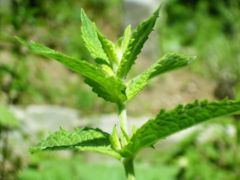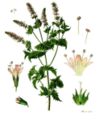Mentha spicata
| Mentha spicata subsp. var. | ||||||||||||||||||||||||||||||||||||||||||||||||||||||||
|---|---|---|---|---|---|---|---|---|---|---|---|---|---|---|---|---|---|---|---|---|---|---|---|---|---|---|---|---|---|---|---|---|---|---|---|---|---|---|---|---|---|---|---|---|---|---|---|---|---|---|---|---|---|---|---|---|

|
|
| ||||||||||||||||||||||||||||||||||||||||||||||||||||||
| ||||||||||||||||||||||||||||||||||||||||||||||||||||||||
Mentha spicata (Spear Mint or Spearmint; syn. M. viridis) is a species of mint probably native to much of Europe and southwest Asia, though its exact natural range is uncertain due to extensive early cultivation. It grows in wet soils.[1][2]
It is a herbaceous rhizomatous perennial plant growing 30–100 cm tall, with variably hairless to hairy stems and foliage, and a wide-spreading fleshy underground rhizome. The leaves are 5–9 cm long and 1.5–3 cm broad, with a serrated margin. The flowers are produced in slender spikes, each flower pink or white, 2.5–3 mm long and broad.[2][3]
Hybrids involving spearmint include Mentha × piperita (Peppermint; hybrid with Mentha aquatica), Mentha × gracilis (Ginger Mint, syn. M. cardiaca; hybrid with Mentha arvensis), and Mentha × villosa (Large Apple Mint, hybrid with Mentha suaveolens).[2]
The name 'spear' mint derives from the pointed leaf tips.[4]
| Standard Cyclopedia of Horticulture |
|---|
|
Mentha spicata, Linn. (M. viridis, Linn.). Spearmint. Fig. 2359. Perennial by leafy stolons: st. erect, with ascending branches 1-2 ft. high: lvs. lanceolate, sharply serrate, 2½ in. or less in length: whorls of fls. in narrow, interrupted spikes 2-4 in. long, the central spike exceeding the lateral ones; calyx-teeth hirsute or glabrate. Widely naturalized about old gardens throughout the older settled parts of the U. S.; native in Eu. and Asia.
|
Cultivation
Spearmint grows well in nearly all temperate climates. Gardeners often grow it in pots or planters due to its invasive spreading roots. The plant prefers partial shade, but can flourish in full sun to mostly shade. Spearmint is best suited to loamy soils with plenty of organic material. Spearmint leaves can be used whole, chopped, or dried. The leaves lose their aromatic appeal after the plant flowers.
The cultivar Mentha spicata 'Nana', the Nana mint of Morocco, possesses a clear, pungent, but mild aroma and is an essential ingredient of Touareg Tea.
Propagation
Pests and diseases
Varieties
Gallery
-
Plant in flower
-
1887 illustration
-
photo 1
-
photo 2
-
photo 3
References
- ↑ Euro+Med Plantbase Project: Mentha spicata
- ↑ 2.0 2.1 2.2 Blamey, M. & Grey-Wilson, C. (1989). Flora of Britain and Northern Europe. ISBN 0-340-40170-2
- ↑ Huxley, A., ed. (1992). New RHS Dictionary of Gardening. Macmillan ISBN 0-333-47494-5.
- ↑ Turner, W. (1568). Herbal. Cited in the Oxford English Dictionary.
- Standard Cyclopedia of Horticulture, by L. H. Bailey, MacMillan Co., 1963
External links
- w:Mentha spicata. Some of the material on this page may be from Wikipedia, under the Creative Commons license.
- Mentha spicata QR Code (Size 50, 100, 200, 500)


